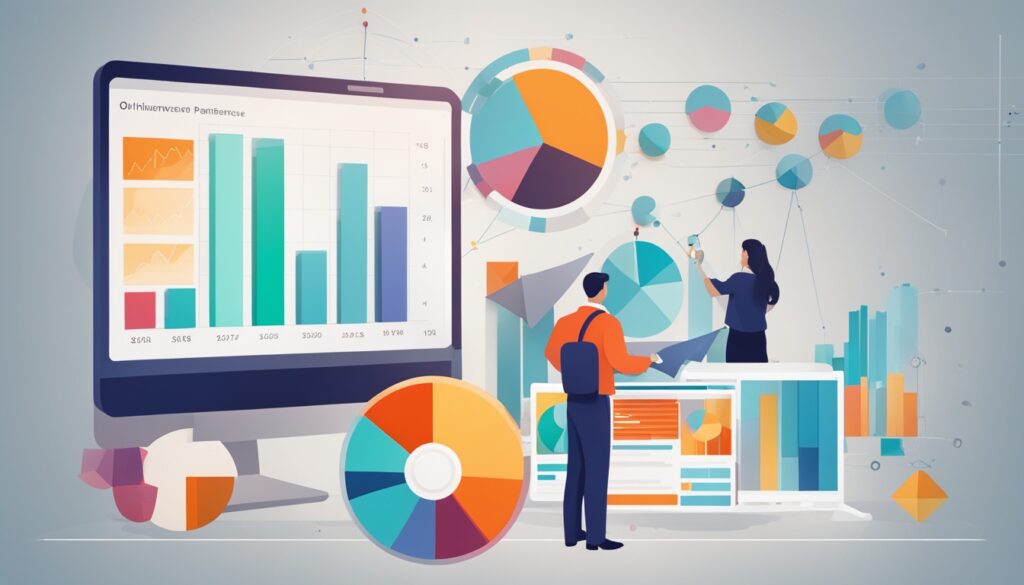Have you ever wondered why some brands quickly become popular, while others struggle to be noticed? The secret might lie in influencer marketing analytics. According to Dave Schneider from NinjaOutreach, influencer marketing lets brands use social media influence to reach more people. Influencers, whether they’re commenting or sharing content, help attract more engagement and visitors to a brand. This shows how powerful influencer analytics can be in making a brand more visible.
Key Takeaways
- Influencer marketing analytics is crucial for understanding and measuring influencer impact.
- Data on influencer engagement can guide brand growth strategies.
- Finding the right influencers can dramatically enhance brand visibility.
- Measuring metrics such as reach and conversion rates is vital for campaign success.
- Effective use of influencer analytics can transform a brand’s outreach efforts.
Introduction to Influencer Analytics
Influencer analytics is a key tool in today’s marketing. It gives insights into how well influencers impact marketing campaigns. By looking at metrics like user engagement and how many people see the content, companies can improve their strategies.
Understanding the Basics
At its heart, influencer marketing analytics means studying data on what social media influencers do. This data helps see which influencers help a campaign succeed. It lets brands look at things like how many new followers they gained or how well they spent their money.
Importance for Brand Growth
Looking closely at social media influencer analysis is crucial for growing a brand. It helps companies tweak their brand expansion strategies to meet their marketing goals. With these insights, brands can choose the best partnerships, making sure their influencer efforts improve their brand and lead to real growth.
| Metrics | Description | Importance |
|---|---|---|
| Engagement Rate | Measures the interaction between the influencer and their followers | High, determines content resonance |
| Reach | Number of unique users who see the influencer’s content | Moderate, reflects audience size |
| Conversion Rate | Percentage of followers who take a desired action | High, indicates campaign effectiveness |
Finding the Right Influencers
Finding and teaming up with the right influencers matters a lot in marketing. It’s all about matching Influencer Performance Metrics with the right Influencer Tracking Tools. This helps brands pick Selecting Brand Influencers that are perfect for their goals and who their customers are.

Types of Influencers
We can sort influencers by how many people follow them and how much they influence:
- Micro-Influencers: They have 1,000 to 100,000 followers. They connect well with their audience and know a lot about what they talk about. This makes them great for focused marketing.
- Macro-Influencers: They speak to 100,000 to 1 million people. They are good for when a brand wants to be seen by more, while still keeping that connection strong.
- Mega-Influencers: With over 1 million followers, their voice is big. But, it’s important to watch how much their followers actually interact with their posts.
Key Criteria for Selection
Picking the perfect influencers means looking at a few key things:
- Audience Alignment: Make sure the people who follow the influencer are the same as who would love your brand. This makes what they say more relevant.
- Authenticity: It’s important for influencers to really care about your brand. Their honest love for it builds trust with their followers.
- Engagement Rates: How much their followers interact with their posts is more important than how many of them there are. Using Influencer Tracking Tools helps you spot this.
- Platform Choice: You should choose influencers whose main social media platforms are where your target audience spends their time.
| Criteria | Micro-Influencers | Macro-Influencers | Mega-Influencers |
|---|---|---|---|
| Typical Audience Size | 1,000 to 100,000 | 100,000 to 1 million | 1 million or more |
| Engagement | High | Moderate to High | Varies |
| Niche Expertise | High | Medium | Low to Medium |
| Reach | Low to Moderate | High | Very High |
Setting Clear Objectives
Setting clear goals is key for influencer marketing to work well. These goals work like a map, directing influencers to meet what you need. Things like making your brand known or selling more can be achieved. Making sure these goals match your brand’s overall aim makes these partnerships strong.
Defining Your Goals
To make the most of influencer campaign analytics, you need SMART goals. These goals are specific, measurable, attainable, relevant, and time-bound. It makes sure your efforts are focused, getting you real results. You may want to reach more people, send them to your website, or make them more engaged. Always have ways to measure how well you’re doing against these goals.
Aligning with Brand Strategy
A successful influencer marketing strategy snugly fits with your brand’s main goals. This way, your influencers’ work supports key brand aims. For example, they might help you get a better position in the market or launch a new item. Regular check-ins and objective-driven campaigns help keep everything on track. They make sure your marketing aligns well with what your customers want and how the market is changing.

Measuring Influencer Performance
Knowing how well influencer campaigns work is key for brands. They do this by watching certain numbers and using special tracking tools. This way, companies can see if their work with influencers pays off well.
Key Performance Metrics
Brands must keep an eye on specific measures to see if their influencer campaigns do their job. They look at engagement rates, click-through rates, and conversion rates. These details give a full picture of how an influencer does, from how people like their stuff to real sales and actions.
Engagement rates show if people are really into what the influencer is sharing. CTR points out how persuasive the influencer is in getting folks to do something. And conversion rates show how many people actually do the thing you want.
Tools for Tracking
Picking the right tools is vital for getting influencer performance right. Choices like Google Analytics offer a deep dive on what people do after seeing an influencer post. Platforms such as AspireIQ and Upfluence help with measuring influencer impact.

Insights from social media, whether right from Instagram and Facebook or special tools, are a big deal too. They let brands see how well users really dive into the content. This all helps with a full look at how influencers are doing for a brand.
Understanding Engagement Metrics
In influencer marketing, we look closely at engagement metrics. They help us see how well campaigns are doing. These metrics show how the audience likes, comments, and shares the content.
This helps brands understand their impact and how far their message spreads. Brands get valuable insights from these interactions.
Likes, Comments, and Shares
For Engagement Rate Analysis, likes, comments, and shares matter a lot. They show how involved the audience is with the content. Each type of interaction reveals something different about viewer interest:
- Likes: A basic form of engagement showing approval.
- Comments: It’s deeper, indicating viewers have thoughts to share.
- Shares: Most valuable, showing the content’s resonance and viral potential.
Audience Interaction Analysis
Studying Audience Interaction helps see what content works best. Brands can then adjust their approach for a better impact. This looks at what the audience likes in content and makes strategies more effective.

| Metric | Importance | Analysis Method |
|---|---|---|
| Likes | Indicates basic approval | Count the number of likes on posts |
| Comments | Shows deeper engagement | Analyze sentiment and volume of comments |
| Shares | Highlights content virality | Track the number of shares across platforms |
Influencer ROI Tracking
It’s key for brands to know how well influencer marketing works. They want to make their Marketing Campaign Profitability better. Influencer ROI Tracking shows the value of working with influencers in the short and long term.
Calculating Return on Investment
The ROI is figured by looking at things like CPA and ROAS. These values show the impact of a brand’s influencer spending:
- Cost Per Acquisition (CPA): Helps see how much to get one customer from an influencer campaign.
- Return on Ad Spend (ROAS): Tells us how much earnings came from every dollar spent on influencers.
By using these measures, we can check if the money spent on marketing is making the brand grow.
Long-Term Benefits
Looking at instant success is important. But, seeing how influencer work keeps benefiting over time is also crucial. Keeping track can show:
- Sustained Brand Loyalty: Working with influencers a lot can make customers stay loyal. This means they keep coming back and trusting the brand.
- Enhanced Brand Recognition: Endorsements from influencers can boost the brand’s visibility over time. This helps the brand grow in the long run.
Measuring both short and long-term effects is vital for a brand’s success with influencers. This ensures not just quick gains but also continued brand health.
Social Media Influencer Analysis
In today’s fast-changing world, knowing about social media influencer analysis is key for your brand’s success. It looks closely at the social media platform impact. It understands what works best on each platform like Instagram, Twitter, and TikTok. This helps create custom strategies because every platform has its own special way of working and audience behavior.
Platform-Specific Insights
Studying each platform specifically helps brands know how to use their unique aspects. For example, Instagram is great for posts with images, while Twitter is best for short, text-based chats. TikTok shines with its quick videos, offering a chance to become viral quickly.
Engagement Rates Across Platforms
How much people engage with content changes from one platform to another. This shows why cross-platform engagement rates are crucial to understand. Knowing these differences helps brands make better influencer campaigns. On Instagram, people might engage a lot with posts because of visual story telling, though Facebook or Twitter might see less interaction on certain kinds of posts.
- Instagram: Known for high visual engagement, benefiting brands with aesthetically appealing content.
- Twitter: Effective for brands leveraging timely news, updates, and engaging in direct conversation.
- TikTok: Excels in short, engaging video content that can quickly go viral, capturing a younger demographic.
Understanding these platform-specific insights helps brands work better with influencers. This way, they get the most out of their social media presence.
Optimizing Influencer Campaigns
Campaign optimization is key in influencer marketing. It uses data insights to better spread content. We focus on making better content and when and how often to post.
Content Strategy Improvements
To improve Influencer Content Optimization, we look at what works best. Working with influencers, we create engaging stories, beautiful images, and videos. It’s crucial to check the data to see what the audience likes and change our plan when needed.
Timing and Frequency
Getting the timing right is vital. We want to post when our audience is most likely to see it. Analytical tools help us pick the best times. It’s also important to find the right balance in how often we post. We aim to keep our audience interested by posting regularly and with variety.
- Analyze engagement data to optimize post timing.
- Adjust content frequency based on audience activity and responses.
- Coordinate with influencers for consistent yet diverse content formats.
Influencer Analytics Tools
Influencer marketing needs good tools to track how well things are going. There are many tools out there. Picking the best one is hard but important. This article looks at some top tools and shows you how to pick the right one for your brand.
Top Tools in the Market
AspireIQ, Upfluence, and HYPR are among the best. They have lots of features and are easy to use. These tools give detailed info on how influencers are doing. This helps brands choose influencers wisely:
- AspireIQ: Brands like AspireIQ for its special features. It lets them make and look after their influencer campaigns easily.
- Upfluence: Upfluence is good because it can find top influencers quickly. It has strong search options and analytics.
- HYPR: HYPR’s strength is its big database and detailed info on influencers. It helps brands pick the right ones for their audience.
Choosing the Right Tool for Your Brand
Choosing the best tool for your brand means looking at what you need and can afford. Here are key things to think about:
- Features: Make sure the tool has the features you need, like tracking and knowing who the audience is.
- Usability: The tool should be simple and work well with your other systems.
- Scalability: Pick a tool that can grow as your influencer campaigns get bigger.
- Cost: Consider whether the cost fits your budget and if it’s worth it for what you get.
Using the best tools can really lift your influencer campaign. When you pick the right tools, your brand can do much better. This means choosing wisely and making the most of what these tools offer.
Conclusion
Understanding influencer analytics is critical for brands looking to grow in the digital era. With data, they can connect with influencers who share their values. This leads to better campaigns and more engagement.
Brands that use analytics to work with influencers see a boost in results. By looking at engagement, reach, and conversions, they can fine-tune strategies. This helps measure campaign success and build lasting ties with influencers.
Using influencer analytics leads to smarter marketing decisions and better outcomes. It lets brands target their audience accurately and achieve lasting market influence. Looking forward, using influencer insights will be key to staying ahead in digital marketing.
FAQ
What is influencer marketing analytics?
Why are influencer analytics important for brand growth?
What types of influencers should brands consider for their campaigns?
What criteria should brands use to select influencers?
How should brands define their goals for influencer marketing campaigns?
What key performance metrics should brands track to measure influencer effectiveness?
What tools are available for tracking influencer performance?
What are engagement metrics and why are they important?
How do brands calculate the return on investment (ROI) for influencer marketing?
How does social media influencer analysis differ across platforms?
What steps can brands take to optimize their influencer campaigns?
What are some of the top influencer analytics tools available?
Source Links
- https://www.printseekers.com/blog-post/mastering-the-art-of-influencer-collaboration-a-guide-for-success
- https://www.linkedin.com/pulse/how-mastering-influencer-marketing-can-grow-your-brand-jordan-wheeler-koqae
- https://www.specflux.com/influencer-marketing/mastering-analytics-in-influencer-marketing-a-comprehensive-guide-to-campaign-metrics/


Leave a Reply